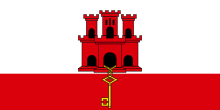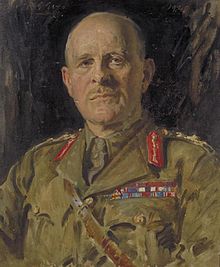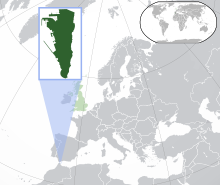Our website is made possible by displaying online advertisements to our visitors.
Please consider supporting us by disabling your ad blocker.
Portal:Gibraltar
The Gibraltar Portal Gibraltar (/dʒɪˈbrɔːltər/ ⓘ jib-RAWL-tər, Spanish: [xiβɾalˈtaɾ]) is a British Overseas Territory and city located at the southern tip of the Iberian Peninsula, on the Bay of Gibraltar, near the exit of the Mediterranean Sea into the Atlantic Ocean (Strait of Gibraltar). It has an area of 6.8 km2 (2.6 sq mi) and is bordered to the north by Spain (Campo de Gibraltar). The landscape is dominated by the Rock of Gibraltar, at the foot of which is a densely populated town area, home to some 34,003 people, primarily Gibraltarians. Gibraltar was founded as a permanent watchtower by the Almohads in 1160. It switched control between the Nasrids, Castilians and Marinids in the Late Middle Ages, acquiring larger strategic clout upon the destruction of nearby Algeciras c. 1375. It became again part of the Crown of Castile in 1462. In 1704, Anglo-Dutch forces captured Gibraltar from Spain during the War of the Spanish Succession, and it was ceded to Great Britain in perpetuity under the Treaty of Utrecht in 1713. It became an important base for the Royal Navy, particularly during the Napoleonic Wars and World War II, as it controlled the narrow entrance and exit to the Mediterranean Sea, the Strait of Gibraltar, with half the world's seaborne trade passing through it. The sovereignty of Gibraltar is a point of contention in Anglo-Spanish relations as Spain asserts a claim to the territory. Gibraltarians overwhelmingly rejected proposals for Spanish sovereignty in a 1967 referendum, and for shared sovereignty in a 2002 referendum. Nevertheless, Gibraltar maintains close economic and cultural links with Spain, with many Gibraltarians speaking Spanish as well as a local dialect known as Llanito. (Full article...) Selected article - The Gibraltar peninsula, located at the far southern end of Iberia, has great strategic importance as a result of its position by the Strait of Gibraltar where the Mediterranean Sea meets the Atlantic Ocean. It has repeatedly been contested between European and North African powers and has endured fourteen sieges since it was first settled in the 11th century. The peninsula's occupants – Moors, Spanish, and British – have built successive layers of fortifications and defences including walls, bastions, casemates, gun batteries, magazines, tunnels and galleries. At their peak in 1865, the fortifications housed around 681 guns mounted in 110 batteries and positions, guarding all land and sea approaches to Gibraltar. The fortifications continued to be in military use until as late as the 1970s and by the time tunnelling ceased in the late 1960s, over 34 miles (55 km) of galleries had been dug in an area of only 2.6 square miles (6.7 km2). Gibraltar's fortifications are clustered in three main areas. The densest fortifications are in the area where historically Gibraltar was under the most threat – at the north end of the peninsula, the North Front, facing the isthmus with Spain. Another group of fortifications guards the town and the harbour, referred to as the West Side. The southern end of the town is guarded by the South Land Front. Few fortifications exist on the east side, as the sheer cliff of the Rock of Gibraltar is a virtually impassable obstacle. Further fortifications occupy the plateaus of Windmill Hill and Europa Point at the southern end of the peninsula. Lookout posts and batteries on the summits of the Rock provide a 360° view across the Strait and far into Spain. Although Gibraltar is now largely demilitarised, many of the fortifications are still intact and some, such as the Great Siege Tunnels and the Charles V Wall – where many of Gibraltar's population of Barbary macaques live – have become tourist attractions. (Full article...) Selected picture Photo credit: Gibnews
The West face of the Rock of Gibraltar, a monolithic limestone promontory. It is 426 metres (1,396 feet) high.
Selected quote
SubcategoriesSelected biography - Field Marshal John Standish Surtees Prendergast Vereker, 6th Viscount Gort, VC, GCB, CBE, DSO & Two Bars, MVO, MC (10 July 1886 – 31 March 1946) was a senior British Army officer. As a young officer during the First World War, he was decorated with the Victoria Cross for his actions during the Battle of the Canal du Nord. During the 1930s he served as Chief of the Imperial General Staff (the professional head of the British Army). He is best known for commanding the British Expeditionary Force that was sent to France in the first year of the Second World War, only to be evacuated from Dunkirk the following year. Gort later served as Governor of Gibraltar and Malta, and High Commissioner for Palestine and Transjordan. (Full article...)
Did you know...
General imagesThe following are images from various Gibraltar-related articles on Wikipedia.
Topics Buildings: The Convent | Dudley Ward Tunnel | Garrison Library | Moorish Castle Communications: .gi | Gibraltar Broadcasting Corporation | Gibraltar Chronicle | Telecom dispute Culture: Cuisine | Gibraltarian people |Gibraltarian status | Languages | Llanito | Music Flora and fauna: Gibraltar Barbary Macaques | Gibraltar candytuft | GONHS | List of birds of Gibraltar | Mammals | List of reptiles and amphibians in Gibraltar | Rock of Gibraltar | The Alameda Gardens History: Battle of Gibraltar | Death on the Rock | Explosion of the RFA Bedenham | George Augustus Eliott, 1st Baron Heathfield | George Rooke | Gibraltar real | Great Siege of Gibraltar | History of the Maltese | History of Nationality | Kingdom of Gibraltar | Military history of Gibraltar during World War II | Moorish Castle | Aurora incident | Pillars of Hercules | Treaty of Utrecht Military: British Forces Gibraltar | Royal Gibraltar Regiment | RAF Gibraltar | HMS Gibraltar | Gibraltar Services Police | Royal Gibraltar Police Symbols: Coat of arms | Flag | Gibraltar Anthem | Other Flags Politics and economy: Chief Minister | Constitution Order (1969, 2006) | Disputed status | Elections | Gibraltar Constitution Order 2006 | Parliament | Gibraltarian pound | Governor | Political parties Religion: Cathedral of St. Mary the Crowned | Cathedral of the Holy Trinity | Great Synagogue | Hinduism | History of the Jews in Gibraltar | Ibrahim-al-Ibrahim Mosque | Methodism | Roman Catholicism | St Andrew's Church Related portalsThings you can doSee alsoAssociated WikimediaThe following Wikimedia Foundation sister projects provide more on this subject:
Discover Wikipedia using portals | ||||||||
Previous Page Next Page

































































